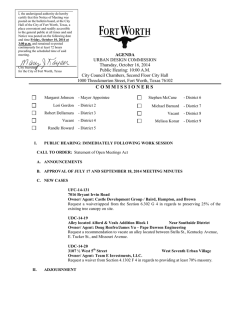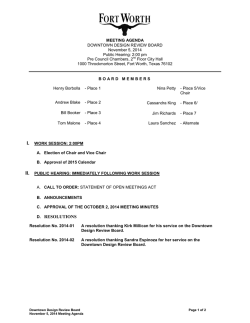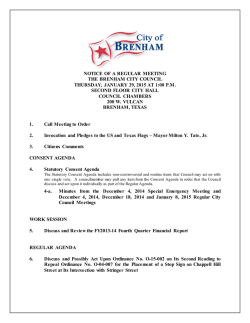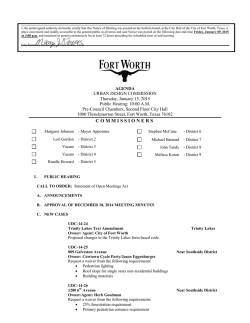
Download PDF version - Texas Department of Public Safety
TEXAS EMERGENCY MANAGEMENT ONLINE 2015 Vol. 62 No. 1 Texas Division of Emergency Management is accepting article submissions for The Texas Emergency Management Online (TEMO) newsletter. If you have an idea for a topic or would like to submit an article, contact Mike Jones at 512-424-7050. Message from the Chief - January 2015 It’s a hard to believe it’s already 2015; weren’t we were just getting ready for the Y2K thing? It looks to like 2015 will be a very interesting year for Texas, full of opportunities and challenges. The 84th Texas Legislature convenes in January, and a new governor takes office. As the new year begins, many concerns from last year and the few years before are still fresh in the minds of people all across Texas: infectious diseases, border issues, population growth, water resources, severe weather and, of course, the lingering drought. As always, the TDEM staff and I look forward to working with the new legislature, local officials and emergency managers across the state to assure that Texas is prepared to respond any threats it faces in the coming year. TDEM is already busy with a slate of projects for 2015. Here are a few in the works: Critical Mass 2015 TDEM will serve as the national host for Critical Mass 2015. This large-scale, mass care exercise will include players from across the nation, including many federal, state and local agencies as well as national voluntary agencies, who will exercise the national response to a catastrophic event. The exercise will require the mutual cooperation from agencies test our ability to respond to massive evacuation, sheltering and feeding needs in Texas. Texas Emergency Management Online 2015 Vol. 62. No. 1; Page 2 Incident Management Teams Under an agreement with Texas A&M Forest Service, TDEM and TFS will continue to develop Incident Management Team capabilities in the state in 2015 and beyond. Under a current project, the efforts will enhance the ability of the state of Texas to develop, mobilize and deploy Type 3 IMTs to support various disaster responses in Texas within eight hours of notification or to support national disaster responses elsewhere in the United States within twenty-four hours of receipt of an Emergency Management Assistance Compact request. The project is funded through an Emergency Management Performance Grant award to the Texas A&M Forest Service. These funds are used to assist the State Type 3 Incident Management Team (IMT) Training Project to train and exercise regional Type 3 All-Hazard IMTs in support of the 2010-2015 Texas Homeland Security Strategic Plan. State Type 3 IMTs, whose members are selected by local and state jurisdictions, are critical in aiding Texas local, regional and state disaster response, as well as supporting disaster response outside the state of Texas through the Emergency Management Assistance Compact. 2015 Texas Emergency Management Conference TDEM will host the 2015 Texas Emergency Management Conference Tuesday, May 12 through Friday, May 15 at the Henry B. Gonzalez Convention Center in San Antonio. Join us at this premier event, learn about what’s happening in emergency management in your community and statewide and network with your colleagues from across the state. Visit the 2015 Texas Emergency Management Conference website and stay tuned for more information. Speaking of opportunities … Is your jurisdiction planning to submit an application for FY 2015 Emergency Management Performance Grant (EMPG) funds? If so, the deadline to submit a completed FY2015 EMPG application package is January 31, 2015. All jurisdictions are eligible as long as they meet the minimum requirements. States receive EMPG funding from the Department of Homeland Security and, in turn, pass it through to local governments to reimburse them for emergency management program expenses. States, including Texas, require local governments that wish to participate in the program to submit EMPG program applications that include a Statement of Work and a program budget. Download the Local Emergency Management Guide on TDEM’s website for more information. Texas Emergency Management Online 2015 Vol. 62. No. 1; Page 3 Rabies in Texas Laura E. Robinson, DVM, MS; Director, Oral Rabies Vaccination Program, Zoonosis Control Branch and Eric Fonken, DVM, MPAff; Zoonosis Control Branch; Texas Department of State Health Services; Texas Department of State Health Services Rabies is a virus that can infect the central nervous system of warm-blooded animals, including humans. Worldwide it kills thousands of people annually, mostly in Africa and Asia, with dogs being the primary source of transmission. In the United States, the canine strain of rabies has been eliminated through the use of effective animal vaccines, the widespread adoption of mandatory vaccinations for dogs and cats, and effective animal control laws, among other strategies. Wildlife, particularly high risk species such as bats, skunks, raccoons, coyotes, and foxes, continue to be a source of rabies infection for domestic animals and humans in Texas. In the mid-1990s, the Department of State Health Services (DSHS) Zoonosis Control Branch (ZCB) initiated successful oral rabies vaccination programs (ORVP) targeting large outbreaks of rabies in foxes in west and west-central Texas and coyotes in south Texas. Today, an ORVP for foxes and coyotes is maintained along the TexasMexico border. In the last decade, skunks and bats have been the primary reservoirs for rabies in Texas, and a study evaluating ORV in skunks was initiated in east-central Texas in 2012. Since the 1980’s, domestically acquired human rabies cases have most commonly resulted from exposure to rabid bats. It has been estimated that in general, about 1% of bats in the wild are infected with the rabies virus, although the risk of infection increases dramatically among sick or downed bats. On average, 10% of the bats submitted for rabies testing in Texas are infected. Most species of bats have very small teeth and a minor bite or scratch may go unnoticed, leaving the victim unaware that they may have been exposed to rabies. Texas law requires that all potential rabies exposures (bites, scratches, or other potential exposures) to humans or domestic animals be reported to the Local Rabies Control Authority (LRCA) and that the exposing animal, if available, be either quarantined and observed (10 days for healthy dogs, cats and ferrets; 30 days for most other domestic animals), or euthanized and tested for rabies at a public health laboratory. State law also requires that all dogs and cats in Texas be vaccinated against rabies by 16 weeks of age. Effective vaccines are available for other species of domestic animals. Rabies virus is present in the saliva of a rabid animal and is primarily transmitted via a bite, although fresh open wounds and mucous membranes are other potential routes of exposure. Avoiding direct physical contact with wildlife, particularly high risk species, is key to preventing rabies in domestic animals and humans. Animal bites or scratches potentially contaminated by saliva should be immediately and thoroughly washed soap and water and an iodine-based antiseptic (if not contraindicated due to allergy) should also be applied to the wound(s). Texas Emergency Management Online 2015 Vol. 62. No. 1; Page 4 If a person is potentially exposed to rabies, the development of clinical disease may be prevented by the timely administration of post-exposure prophylaxis (PEP), which consists of the administration of human rabies immune globulin (HRIG) and 4 doses of vaccine over a period of 2 weeks. If PEP is not administered or not administered in a timely manner, clinical rabies may develop, resulting in death in almost all cases. The clinical course of rabies in humans and animals is divided into three stages: an asymptomatic incubation period, overt clinical illness, and death. The incubation period is highly variable and depends on a number of factors, including the amount and strain of virus inoculated, the location of the bite, the type of animal infected, and the age and immune status of the victim. Typically, the incubation period in humans lasts one to three months, although it can be as short as 1 week or longer than 1 year in rare instances. Once clinical illness becomes apparent, the disease is rapidly progressive in both animals and humans. The saliva, cerebrospinal fluid and nervous tissue of a clinically ill human or animal are considered infectious for rabies. Initial symptoms of rabies in humans often include fever, pain or altered sensations at the wound site, headache, and malaise. As the disease progresses, more overt and progressive neurologic symptoms develop and can include limb weakness or paralysis, behavior changes, hallucinations, insomnia, hydrophobia (abnormal fear of water) and/or aerophobia (abnormal fear of air flow), seizures, and coma, followed in almost all cases by death. In animals, the first symptoms of rabies may be nonspecific and include lethargy, fever, vomiting, and anorexia. Signs progress within days to cerebral dysfunction, cranial nerve dysfunction, ataxia, weakness, paralysis, seizures, difficulty breathing, difficulty swallowing, excessive salivation, abnormal behavior, aggression, and/or self-mutilation, followed by death. Humans exposed to rabies should receive timely PEP. Domestic animals exposed to rabies must either be euthanized or undergo PEP, if a licensed vaccine is available for that species, and isolated for a specified period of time, depending on the vaccination status of the animal at the time of the exposure. ZCB personnel are available for consultation related to potential rabies exposures, including exposure risk assessment, LRCA contact information, PEP recommendations, and sources of rabies vaccine and HRIG for medical providers. To locate the Regional ZCB office for your area, please see the map on the DSHS website at http://www.dshs.state.tx.us/idcu/health/zoonosis/contact/. Additional information about rabies and other zoonotic diseases in Texas may be found at http://www.dshs.state.tx.us/idcu/health/zoonosis/. Links: Rabies in Texas - DSHS Oral Rabies Vaccination Program - DSHS Learning About Bats - CDC Seeking Medical Attention - CDC Texas Emergency Management Online 2015 Vol. 62. No. 1; Page 5 Texas Winter 2014-2015 By Meteorologist Aaron Treadway National Weather Service, New Braunfels, TX What is the Outlook for winter? The Climate Prediction Center (CPC) has issued their winter 2014/2015 outlook. This outlook for the months of December, January, and February is just one of the outlooks that the CPC issues for various time periods. These outlooks are pictured below. As you can see the CPC is predicting a 40% chance that the winter months will be both wetter and cooler across much of the state of Texas. As we near the end of 2014 many areas in Central and North Texas are still 4 to 12 inches below normal in terms of rainfall, with parts of North Texas still experiencing Extreme to Exceptional Drought. Part of the reason for cooler and wetter winter forecast is the predicted onset of a weak El Nino (see a previous article on the impacts of El Niño on Texas). Although we currently remain in an ENSO Neutral state, the CPC still maintains a 65% chance of a weak El Niño developing through the rest of 2014 and into the early months of 2015. How do November and December of 2014 compare to the same time last year? What a difference a year makes! If you remember how cold last year was, you’re not alone. Starting in November of 2013, it seemed as if every week there was some sort of arctic outbreak with cold air and chances of frozen precipitation. Several arctic air masses pushed south out of Canada and plunged all the way to the Gulf Coast. These cold air outbreaks brought freezing rain as far south as the Austin area and produced 1-2 Inches of ice and sleet across the DFW Metro Area. So what about this year? After an early cold air outbreak in the middle of November this year, most of Texas has enjoyed very mild temperatures the past several weeks. Over the first two weeks of December we have seen near to above normal high and low temperatures. This is due to the majority of the weather systems impacting Texas originating over the Pacific and western United States rather than Canada. Below is a table of average high and low temperatures through the first 16 days of December comparing 2013 and 2014. You can see that the average highs and lows are all 10 to 15 degrees warmer in 2014 compared to 2013. Although we are a few weeks into meteorological winter, astronomical winter does not begin until Sunday, December 21st. We still have the rest of December through January and February ahead of us. Texas Emergency Management Online 2015 Vol. 62. No. 1; Page 6 2013 December* Average Lows 38.2 2014 December* Average Highs 66.6 2014 December* Average Lows Austin Mabry 2013 December* Average Highs 58.4 Amarillo 47.9 20.3 57.6 32.6 Dallas 51.1 31.9 61.8 46.1 Houston 59.5 41.7 51.6 70.1 st *Averages only pertain to December 1 52.1 th – December 16 Links and Sources: • http://www.noaanews.noaa.gov/stories2014/20141016_winteroutlook.html • http://droughtmonitor.unl.edu/Home/StateDroughtMonitor.aspx?TX • http://www.nws.noaa.gov/climate/xmacis.php?wfo=ewx Texas Emergency Management Online 2015 Vol. 62. No. 1; Page 7 Texas Critical Infrastructure Protection The Texas Office of Critical Infrastructure Protection (OCIP) is charged with coordinating efforts among private sector partners and state, regional, local, and federal agencies to enhance the security and resilience of critical infrastructure systems throughout the State of Texas from all hazards and threats. The OCIP is located within the Homeland Security Unit of the Texas Joint Crime Information Center Texas (JCIC). It supports the DPS Homeland Security and Emergency Management Missions through fostering partnerships with critical infrastructure owners and operators, threat and vulnerability analysis, and managing information related to critical infrastructure systems in Texas. This mission is a shared responsibility between the private sector owners/operators of critical infrastructure systems and government partners. Information sharing is the lifeblood of this effort as it is required to fully understand the nature of the many threats to our communities and the potential cascade of consequences associated with them. The Texas Infrastructure Security and Resilience Plan (TISR) provides the strategic blueprint to guide the strategy. The plan published in October 2014 is a valuable reference that articulates the value of the public-private partnership, explains the roles of partners, and describes the partnership structure for coordinating infrastructure security and resilience activities. • • • • • • • • Critical Infrastructure Sectors Agriculture and Food • Financial Services Chemical • Government Facilities Commercial Facilities • Information Technology Communications • Manufacturing Dams • Nuclear Reactors, Materials, and Waste Defense Industrial • Public Health and Base Healthcare Emergency Services • Transportation Systems Energy • Water and Wastewater The OCIP is located within the Homeland Security Unit of the Texas Joint Crime Information Center Texas (JCIC). It supports the DPS Homeland Security and Emergency Management Missions The Texas Office of Critical Infrastructure Protection administers several programs and information sharing platforms of particular interest to the emergency management community. These provide information about threats vulnerabilities and critical infrastructure systems. Homeland Secutiry Information Network (HSIN) Texas Infrastructure Protection (TX-IP) This portal provides a restricted access all hazards / threats information sharing platform between federal, state, local jurisdictions, and the private sector to effectively and efficiently help the state mitigate against, prepare for, respond to, and recover from emergencies or disasters pertaining to critical infrastructure and key resources. Texas Emergency Management Online 2015 Vol. 62. No. 1; Page 8 Protected Critical Infrastructure Information (PCII) This is an informationprotection program that enhances voluntary information sharing between infrastructure owners and operators and the government. PCII protections mean that homeland security partners can be confident that sharing their information with the government will not expose sensitive or proprietary data. The Texas Office of Critical Infrastructure Protection is the point of contact regarding this program in the State of Texas. Critical Infrastructure Data Call This is an on-going effort to collect information about critical infrastructure assets and systems in an effort to better understand these systems to support risk and vulnerability analysis and planning efforts. Data collected through this effort helps the state organize and prioritize infrastructure systems by potential impacts associated with disruptions. Infrastructure Protection (IP) Gateway The IP Gateway is a federal portal in which state and local access for Texas is administered in Texas by the OCIP. It provides various data collection, analysis, and response tools in one integrated system streamlining access to infrastructure protection tools and datasets. More information regarding this system will be provided during the roll-out in early 2015. For further information about these programs, or to request access for users, contact the Office of Texas Infrastructure Protection at [email protected]. Texas Emergency Management Online 2015 Vol. 62. No. 1; Page 9 News Briefs Winter Weather Preparedness Outlook – An outlook is used to indicate that a hazardous winter weather event may develop. It is intended to provide information to those who need considerable lead time to prepare for the event. Watch – A watch is used when the risk of a hazardous winter weather event has increased, but its occurrence, location, and/or timing is still uncertain. It is intended to provide enough lead time so those who need to set their plans in motion can do so. When a watch is issued, it’s prudent to listen to NOAA Weather Radio All Hazards and check the forecast frequently at NOAA’s National Weather Service Web site. Warning/Advisory – These products are issued when a hazardous winter weather event is occurring, is imminent, or has a very high probability of occurrence. A warning is used for conditions posing a threat to life or property. An advisory is for less serious conditions that cause significant inconvenience and, if caution is not exercised, could lead to situations that may threaten life and property. Before, during and after a storm, pay close attention to your local National Weather Service forecast for detailed information on the type of weather conditions expected, accumulations, possible impacts, as well as advisories, watches and warnings. Drive safer this winter To keep safe, consider doing the following before driving in winter weather conditions, especially if the National Weather Service has issued warnings or watches in your area: • • • • • Keep the gas tank full to keep the fuel line from freezing. Let someone know your destination, route, and when you expect to arrive. Keep a cell phone or other emergency communication device with you. Pack your car with thermal blankets, extra winter clothes, basic tool kit, (including a good knife and jumper cables), an ice scraper and shovel, flashlights or battery-powered lanterns with extra batteries, and high calorie, nonperishable food, and water. Use sand or kitty litter under your tires for extra traction, especially if you find yourself stuck in a slippery spot. Ready.Gov Winter Weather National Oceanic and Atmospheric Administration Texas Emergency Management Online 2015 Vol. 62. No. 1; Page 10 U.S. Climate Resilience Toolkit In response to the President's Executive Order 13653, a NOAA-led U.S. federal agency partnership released the U.S. Climate Resilience Toolkit to provide tools, information, & scientific expertise to help communities & businesses build resilience to climate-related impacts & extreme events. Meet the Challenges of a Changing Climate The Climate Resilience Toolkit provides resources and a framework for understanding and addressing the climate issues that impact people and their communities. Every community and business faces some risk of climate-related disruptions to their operations. For some, it’s not a question of “if” but “when” disruptions will occur. Anticipating potential problems and preparing to prevent or respond to them can make it easier to bounce back from disruptions. There’s no single approach to building climate resilience. Communities and businesses across the nation are already using the Toolkit to confront their climate vulnerabilities and build resilience, and you can too. Climate Resilience Toolkit Texas Emergency Management Online 2015 Vol. 62. No. 1; Page 11 January 2015: Credits ASSISTANT DIRECTOR/CHIEF W. Nim Kidd DEPUTY ASSISTANT DIRECTORS Paula Logan Tom Polonis Sandra Fulenwider EDITORS Suzannah Jones Mike Jones GRAPHIC DESIGNER Mike Jones WEBSITE DPS Web Team CONTRIBUTORS Laura E. Robinson, DVM, MS; Director, Oral Rabies Vaccination Program, Zoonosis Control Branch and Eric Fonken, DVM, MPAff; Zoonosis Control Branch Texas Department of State Health Services Meteorologist Aaron Treadway National Weather Service, New Braunfels, TX David Jackson, DPS DIGITAL IMAGES CONTRIBUTED BY: Texas Division of Emergency Management TEXAS EMERGENCY MANAGEMENT ONLINE is a free publication. Reprinting of content in articles is permitted with credit. Texas Emergency Management Online 2015 Vol. 62. No. 1; Page 12 Note: links to [PDF] files require Adobe Reader or another PDF viewer. Back to Top
© Copyright 2025




